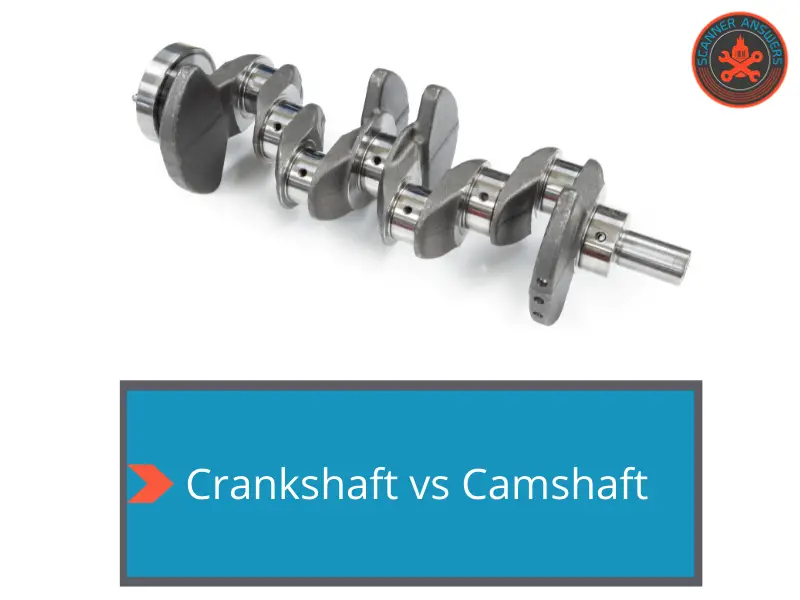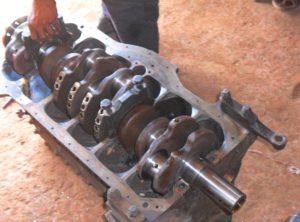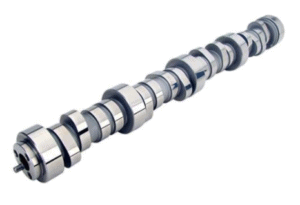
Although internal combustion engines comprise several complex shafts, gears, and other components, the crankshaft and camshaft are critical ones. These are distinct kinds of shafts that serve particular purposes within the engines, including sending torque to the transmission and assisting in kickstarting its cycle. When learning how an engine works, I need to know that there are several differences between a crankshaft vs camshaft. Despite the differences, both are linked together such that if I have a vehicle with four-stock engines, it cannot effectively run if it does not have such components. In this guide, I will highlight more regarding the relationship between the camshaft vs crankshaft.

What is a Crankshaft?
It refers to an engine component that converts reciprocating (linear) piston motion into rotary motion. It is designed using ductile iron, and it is the main rotating part of an engine.
The crankshaft has additional bearing surfaces known as crankpins or crank throws, whose axis forms the base of the ends of the connecting rods from every engine cylinder attack.
Normally, the crankshaft is connected to a flywheel to minimize the pulsation action of the four-stroke cycle.
It might also have a vibration or torsional damper at the opposite end to minimize torsional vibrations generated at the crankshaft length by cylinders from an output end resting on the metal. Most importantly, all major engine components, including connecting rod and piston, are supported by the crankshaft.

What is a Camshaft?
A camshaft is a long metal rod where numerous external components are attached. One object involves egg-shaped lobes that initiate the closing and opening functions of exhaust and intake valves. Such perfectly timed and installed lobes ensure that my vehicle functions properly through the combustion process.
Most modern engines come with a dual overhead camshaft design, where two cams are placed on every side of a machine. In such a case, one of the cams functions to control the opening times of the exhaust valves while the other controls how the intake valves open.
Other vehicle engines have a quad camshaft (four camshafts). However, when a vehicle has several camshafts, it does not mean that it can provide a better performance, but they add to design variety. In reality, most engines with one offer good performance.
Numerous belts, gears, and chains control the camshaft to attain precise timing. If I have the latest vehicle model, I might realize that it has a Variable Valve Timing Solenoid to help regulate the camshaft duration and lift according to the engine’s needs.
Where are the Camshafts and Crankshafts located?
The crankshaft is found in the crankcase.
The crankshaft rides on bearings that can wear with time. However, the bearings support the crankshaft and rods that connect pistons to a crankshaft.
In contrast, depending on the location, this part can directly operate the valves or through the linkage of rockers and pushrods.
In most cases, the camshaft is supposed to be positioned at the top of the engine cylinder. Such a direction operates a simple mechanism and results in limited failure.
P0008 and P0016 are common OBD2 DTC codes you might see if these parts have trouble
How is the Crankshaft built?
A crankshaft construction resembles an eccentric, but the eccentric has a smaller diameter than the shaft. The length of the crankshaft varies depending on the number of cylinders within an engine.
The crankshaft comprises molten iron, which undergoes rigorous polishing to ensure that it experiences limited friction.
The crankshaft has two journals that refer to sections of the shaft that rotate inside a bearing. The first one is the connecting rod journals, then links connecting rods to pistons. The second one is the main bearing journal located closer to the axis of rotation or shaft.
The crankshaft has an anterior portion referred to as the nose that contains a toothed gear connected with numerous other parts, including a valve train and a pulley. There is also a flywheel that is located towards the posterior area of the shaft.
The flywheel plays a critical role in the movement of a vehicle. It is vital to ensure that the journals do not experience friction since the crankshaft will be subjected to continuous motion while driving a vehicle. Such a case explains why the crankshaft has a specialized pathway so that oil can move through, making the rob to be effectively lubricated.
Related: Troubleshooting a bad crankshaft position sensor
How is the Camshaft built?
The design features a long bar of eccentric egg-shaped lobes where one of them acts as a fuel injector and the other for every valve. I need to know that the camshaft is a rod that is also referred to as the shaft, and it contains numerous cams. This component has several parts known as journals.
There is a cam position sensor at the front area of the camshaft that functions to detect rotation in the cam angle to initiate movement within the cylinder. The combustion cycle is the one that contributes to the movement in the cylinder.
Every cam has a head at the tip of the eccentric egg-shaped lobe. Also, it has a more rounded portion at the bottom end known as a heel. The area adjacent to the camshaft position sensor is referred to as the trust, and it assists in ensuring the shaft stays in place while the car engine runs.
Speed
The crankshaft drives the camshaft either by timing gears (a pair of meshing gears) or by a pair of timing sprockets linked by a chain. In this case, the sprocket or camshaft gear has twice the number of teeth on the sprocket on the crankshaft. That gives it a gear ratio of 1:2, meaning the camshaft turns at half the speed of a crankshaft.
Two camshaft revolutions will generate one revolution of the crankshaft and one closing and opening of every valve in a four-cylinder engine.
The sprocket and gear maintain a definite time relationship between the camshaft and crankshaft to ensure that the valves open exactly at the appropriate time according to the piston position.
FAQs
Does the crankshaft turn the camshaft?
Yes. The crankshaft spins and such spinning helps in turning the chain or timing belt that rotates the camshaft. At the same time, the camshaft takes that rotational motion and employs it to repeatedly lower and raise the intake and exhaust valves of the car engine.
Are a cam and camshaft the same?
No. The camshaft regulates fuel power and fuel flow, while the crankshaft helps convert energy to forward motion. In other words, the camshaft ensures that the valves function according to their intended design, and the crankshaft offers power that is used to operate a vehicle.
Both components should work collaboratively for a vehicle to perform well.
What’s the difference between the crankshaft and camshaft position sensor?
The camshaft position sensor helps determine the firing cylinder to synchronize the coil firing and fuel injector sequence. In contrast, the crankshaft position sensor functions as a multifunctional sensor that assists in establishing ignition timing, detecting relative engine speed and RPM.
What turns faster, crank or cam?
The camshaft turns 1/2 the crankshaft speed. Therefore, the camshaft completes valve operation for a whole engine cycle since a four-stroke engine makes two crankshaft revolutions to finish one cycle.
Both camshafts and crankshafts are critical components in the drivetrain of a vehicle. The relationship between the two components impacts the performance of a machine in several ways. Further, both have sensors that ensure that they work appropriately. Most importantly, the two parts should move harmoniously to function effectively. Therefore, there should be precise timing between the two through a timing belt connection.